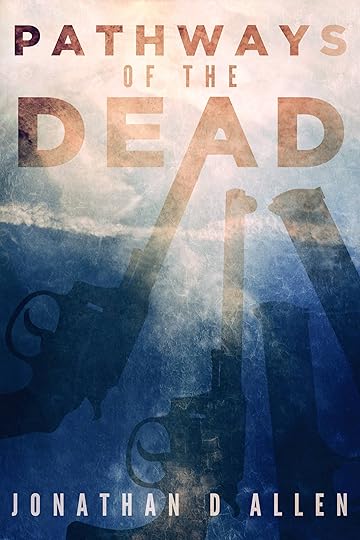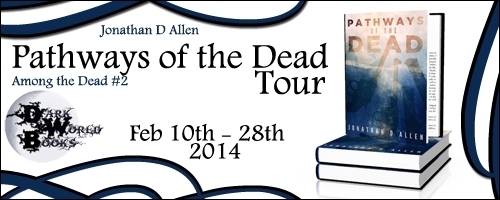Jonathan D. Allen Looks at Limerence and His Newest Release
 Pathways of the Dead(Among the Dead #2)Matty doesn’t want to end the world. Unfortunately, she has no choice. Through a series of harrowing events, Matty DiCamillo discovered that she is the heir to an ancient prophecy, destined to destroy her own reality to save countless others. Now she finds herself locked away and interrogated by beings known as the Aetelia, who are out to force the apocalypse to their liking. After a breathless escape and an attack by the band of rebel Aetelia known as the Watchers, Matty must not only cross worlds but time itself to elude capture and face her destiny on her own terms. Aided by her lover Kristy; Tommy, a man trapped in a boy’s body; and an ageless woman named Omarosa; she must face death itself to reach the City of the Dead.AmazonAdd Pathways of the Dead to your Goodreads list!_________________________About The Corridors of the Dead (Book #1)Long ago, a mysterious being known as The Lost Aetelia crafted an elaborate series of Watchtowers, along with their resident guardians, the Aetelia, to watch over the Universe. In time, they sent a select group of their own to Earth, tasked with watching over the fledging human race. This group used humanity to challenge the established structure of the Universe. A bitter war ensued, and these rebels, who had come to be known as Watchers, disappeared from history.
Pathways of the Dead(Among the Dead #2)Matty doesn’t want to end the world. Unfortunately, she has no choice. Through a series of harrowing events, Matty DiCamillo discovered that she is the heir to an ancient prophecy, destined to destroy her own reality to save countless others. Now she finds herself locked away and interrogated by beings known as the Aetelia, who are out to force the apocalypse to their liking. After a breathless escape and an attack by the band of rebel Aetelia known as the Watchers, Matty must not only cross worlds but time itself to elude capture and face her destiny on her own terms. Aided by her lover Kristy; Tommy, a man trapped in a boy’s body; and an ageless woman named Omarosa; she must face death itself to reach the City of the Dead.AmazonAdd Pathways of the Dead to your Goodreads list!_________________________About The Corridors of the Dead (Book #1)Long ago, a mysterious being known as The Lost Aetelia crafted an elaborate series of Watchtowers, along with their resident guardians, the Aetelia, to watch over the Universe. In time, they sent a select group of their own to Earth, tasked with watching over the fledging human race. This group used humanity to challenge the established structure of the Universe. A bitter war ensued, and these rebels, who had come to be known as Watchers, disappeared from history.
 The time of the Aetelia – now known as angels – is returning. After a fateful night of violence, Artist Matty DiCamillo finds herself drawn into this world by a mysterious savior, who becomes a driving force in Matty’s new life. Both driven by and fighting the words of prophecy that lay out her destiny, Matty, her lover Kristy, and her best friend Daniel, follow this mysterious savior on a journey from Northern California to Las Vegas on a path that crosses through the boundaries of time and space. As Matty struggles to understand her destiny, she discovers that her savior may not be what she seems, and that even the denizens of this twilight world have no idea what lurks behind the stage dressing of reality. Matty finds herself not only racing to rescue the woman she loves, but learning that she herself could be the cause of the Universe’s day of reckoning.Amazon – Barnes & Noble
The time of the Aetelia – now known as angels – is returning. After a fateful night of violence, Artist Matty DiCamillo finds herself drawn into this world by a mysterious savior, who becomes a driving force in Matty’s new life. Both driven by and fighting the words of prophecy that lay out her destiny, Matty, her lover Kristy, and her best friend Daniel, follow this mysterious savior on a journey from Northern California to Las Vegas on a path that crosses through the boundaries of time and space. As Matty struggles to understand her destiny, she discovers that her savior may not be what she seems, and that even the denizens of this twilight world have no idea what lurks behind the stage dressing of reality. Matty finds herself not only racing to rescue the woman she loves, but learning that she herself could be the cause of the Universe’s day of reckoning.Amazon – Barnes & NobleJonathan D Allen
 Born and raised in the rural Shenandoah Valley of Virginia, Jonathan wrote his first fantasy/sci-fi novel at the age of 13. After studying writing and communication at James Madison University, Jonathan turned his passion for writing into a full-time technical writing career in the DC Metro area, working for companies like Sprint/Nextel, Time Warner Cable, and Sirius XM Radio, where he had an opportunity to combine his love of music with his love of writing. He may have drifted away from fiction at times, but it was always his first love – and he always returned to it. Now living in Bethesda with his wife, two cats, and two quirky guinea pigs for which his publishing company is named, he crafts the kinds of stories that he had always hoped to read but just couldn’t quite find.Website – Blog – Twitter – Facebook – Pinterest
Born and raised in the rural Shenandoah Valley of Virginia, Jonathan wrote his first fantasy/sci-fi novel at the age of 13. After studying writing and communication at James Madison University, Jonathan turned his passion for writing into a full-time technical writing career in the DC Metro area, working for companies like Sprint/Nextel, Time Warner Cable, and Sirius XM Radio, where he had an opportunity to combine his love of music with his love of writing. He may have drifted away from fiction at times, but it was always his first love – and he always returned to it. Now living in Bethesda with his wife, two cats, and two quirky guinea pigs for which his publishing company is named, he crafts the kinds of stories that he had always hoped to read but just couldn’t quite find.Website – Blog – Twitter – Facebook – Pinterest I'm happy to host the tour for the dark fantasy novel Pathways of the Dead by Jonathan D Allen! The tour is running from February 10th to 28th, 2014. There will be reviews, interviews, guest posts and excerpts + a special International giveaway that will run on each tour stop! a Rafflecopter giveaway
I'm happy to host the tour for the dark fantasy novel Pathways of the Dead by Jonathan D Allen! The tour is running from February 10th to 28th, 2014. There will be reviews, interviews, guest posts and excerpts + a special International giveaway that will run on each tour stop! a Rafflecopter giveawayGuest Post from the author...
Love and Madness Among the Dead
Hi there, thanks for joining me on the Pathways of the Dead virtual book tour. As always, I’m humbled at the chance to share with a new audience and thank our gracious host. Given that tomorrow is Valentine’s Day, I decided to discuss love and madness, two topics that immediately come to mind when I contemplate said holiday.
What, they don’t occur to you?
“Uh, that’s great, Jonathan,” you say, “But this is a book tour, right? What does it have to do with the book?” Good question! Let’s dig down into it and talk about how the two concepts intertwine in the Among the Dead Cycle, as they are very subtle, but important, themes in the series.
I write this knowing that it is not very subtle or clever to equate love and craziness, more a fact of life. In addition to the time-worn cultural equations between the two, science has discovered that people in the throes of romantic love have similar MRI profiles to the mentally ill, specifically those with Obsessive Compulsive Disorder (OCD). We all know the stupid things that people do under its sway (and I am certainly not immune to this). So why celebrate it if it can cause such issues in our lives?
The problem, I believe, stems from a confusion of definitions. Many people confuse the physical experience of limerencewith love. Quick thumbnail sketch, limerence is an involuntary state of mind in which you become obsessed with the target of your affections. This may be requited or unrequited, but the key defining trait is obsession and the need to have your affections returned. Not surprisingly, it bears a striking resemblance to OCD.
Limerence, then, is that crazy phase where you can’t get someone out of your mind and drive your friends out of their minds with constant chatter about the new love of your life. Every waking minute may be filled with a desire to be with that person, a burning need only quenched by proximity to the target. It’s a head-spinning, heart-pounding, pleasant-and-awful crazy rush of endorphins flooding your body. Opinions differ on what triggers this particular state, but most psychologists agree that it’s a recognition of something familiar in that other person, and that familiar trait may be good or bad. Add this to people writing songs about this state of mind, lauding it as “true love” and you have a recipe for something quite dangerous and addictive.
But is it really love, part of love, or something else entirely? Everyone knows some story of a couple who started out madly in love with one another and eventually ended up with a collapsed, black hole of a relationship. “Oh, I love him, but I’m not in love with him,” is the common refrain at the end of such engagements. Sometimes the decision to dissolve these bonds is absolutely the right thing to do; madness can make for strange bedfellows that make very little sense in the light of day.
On the other hand, a relationship that has “lost its spark” (i.e., fallen out of limerence) can be sustained long-term by hard work and dedication. Is that love? Well, in 1956 the social psychologist Erich Fromm published a book called The Art of Loving and it posited love as a skill rather than an emotion, something that a person could practice daily with everyone, not just the object of their affection. The notion was hardly new. The exhortation is, after all, the basis of Jesus’ teachings, among other spiritual edicts, and underlies many acts of civil defiance in the name of justice. So we’re left with the idea that what begins with limerence can become something stronger and long-lasting with a little patience, work, and directed will.
This is where my series enters the picture, as I crafted portions of the story as a metaphor for this process. In Book One, The Corridors of the Dead, protagonist Matty DiCamillo finds herself thrust into a world that she doesn’t understand, forced to deal with the entreaties of a hidden world, the world of the Aetelia, that has sought her for untold millennia. The imposing, undiscovered reality is in limerence, determined to snag the object of its affection one way or another. Matty’s “suitors” violently impose on an existing relationship with Matty’s girlfriend Kristy. Kristy finds herself increasingly pushed into the background of Matty’s life as this new pseudo-relationship with the world of the Aetelia takes shape. With this comes the madness of a new infatuation and entry into a previously unimagined state of consciousness. I think you can fill in the parallels.
By Book Two, Pathways of the Dead, Matty has accepted her fate and locks into the world of this new relationship, toxic though it may be. Now the focus begins to shift to Kristy and her efforts to deal with this change in her life. Matty and Kristy connect a few times, but a desperate, insane act by Kristy at the end of Book One has driven a wedge between the two that will never entirely be removed. They continue to have an important bond, but it is Kristy’s turn to learn, and her lesson is much closer to Fromm’s definition of love. She has been drawn into this world along with Matty, but in contrast to her lover, Kristy takes conscious steps to help avert the apocalypse, fully shouldering the responsibility for saving the Multiverse in an act of love that even she doesn’t understand until the very end.
So you see, the two women experience very different sides of the same coin; Matty’s encounter with this world represents the limerence and mad dash of being pulled along by fate and forces beyond your control, while Kristy’s experience is built around conscious will and the hesitant steps of learning to truly care for others. The differences in their experiences drive the series finale (still to come in Book 4), in which we see the long-lasting ramifications of their choices - or non-choices.
Limerence and the act of love may be very different things, but they will always be connected at the hip. The question is how we handle them and their impacts on our lives. My hope is that Kristy and Matty provide good models for the future.
Published on February 12, 2014 23:00
No comments have been added yet.



